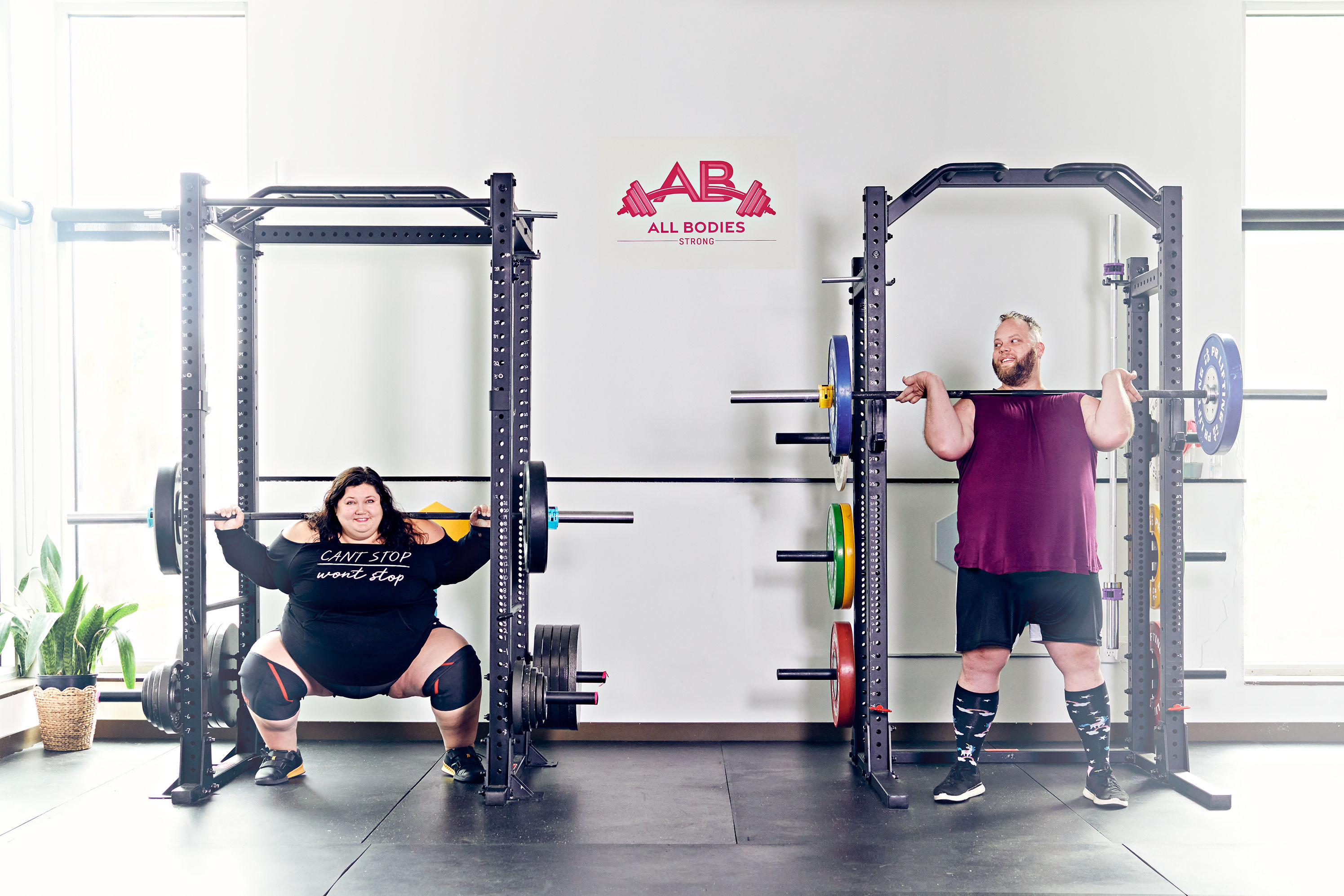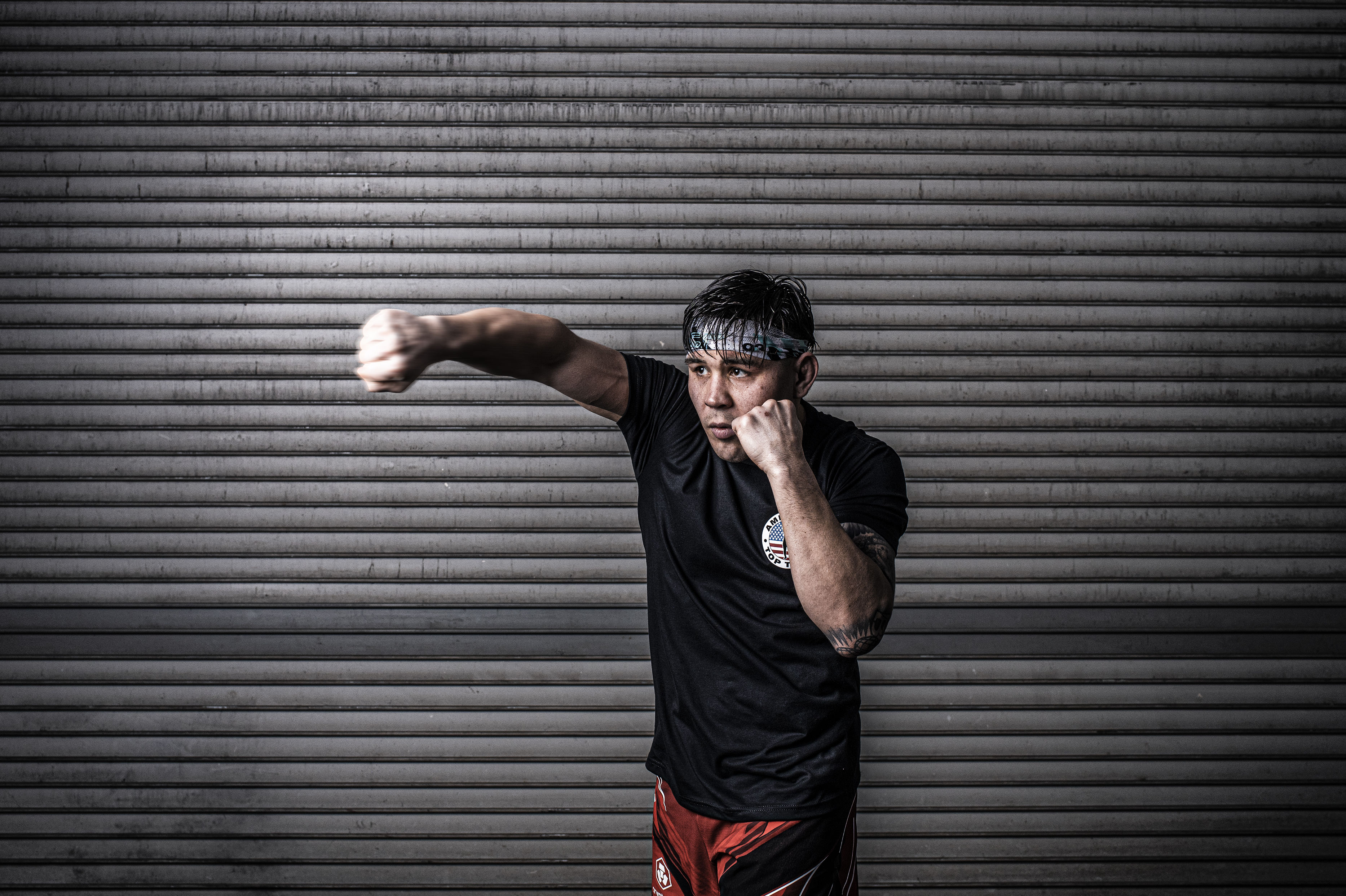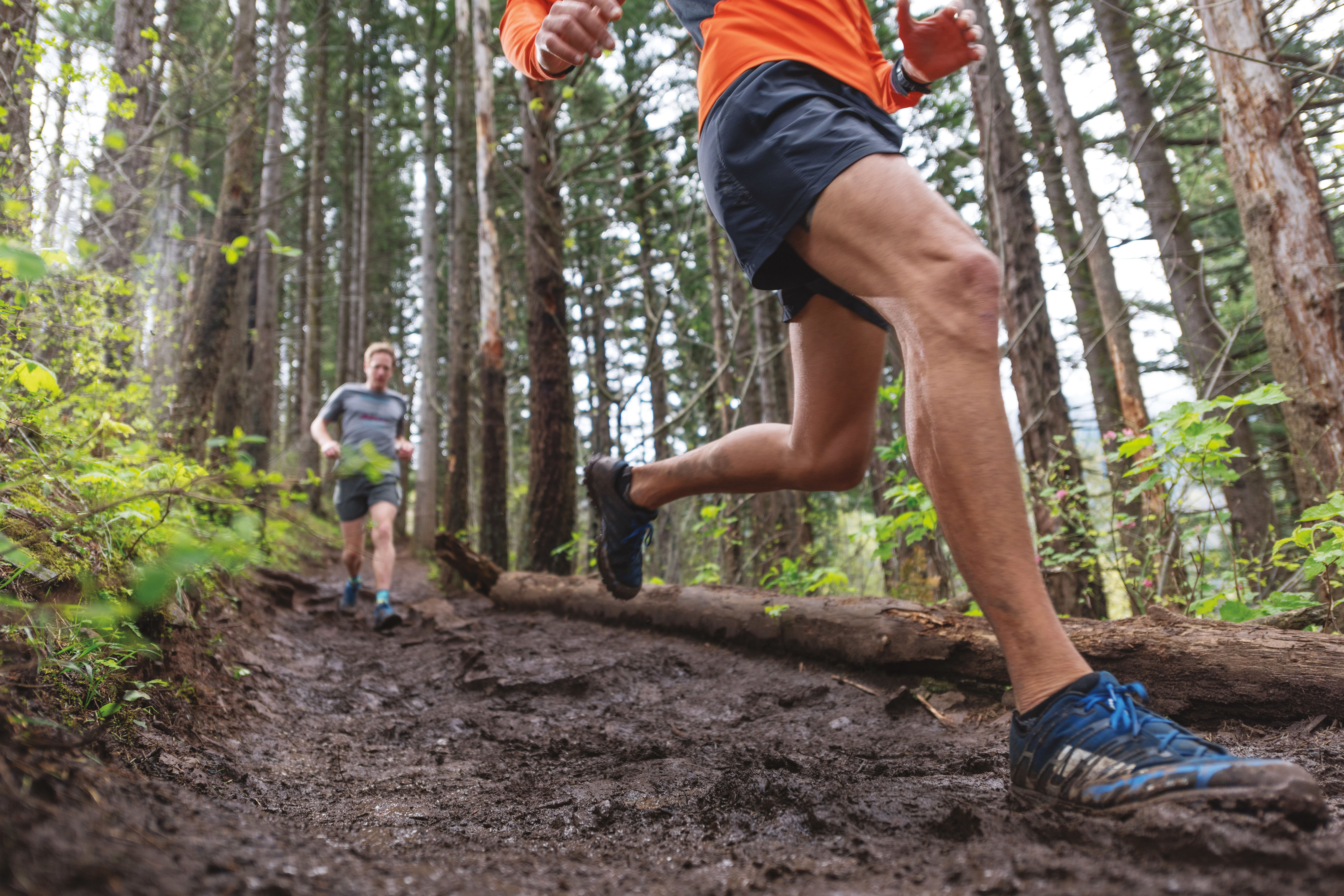
Zen and the Art of 100-Mile Marathons
"I look at it this way,” says Willie McBride, a Portland endurance athlete and coach, as he makes quick work of a breakfast burrito loaded with tofu, kale, and cashew sour cream. “In a day in a normal life, your average person asks 20 percent from their body. An ultrarunner asks close to 100 percent of their body. Your average person is like, ‘You’re crazy—you’re getting injured.’ I just think, ‘Yeah. You’re not going to get injured if you’re only asking 20 percent.’”
“A major injury is almost like a rite of passage,” Yassine Diboun, McBride’s partner in training and business, chimes in, over a plate of soy-curl bibimbap. “Your tendons and ligaments and connective tissues are just like, ‘What the hell?!’ And then, as you overcome that injury, you get stronger.”
Between them, 36-year-old Diboun and 33-year-old McBride have completed more than 100 ultramarathons, extended endurance adventures, and daring climbs. They have the injuries and scars to prove it. (Just for example: McBride’s broken wrist, suffered in a climbing fall, complete with bone sticking out of hand; Diboun’s collision with a car during a triathlon training run, complete with Life Flight helicopter ride and multiple skin grafts to treat severe road rash.) As co-owners of Animal Athletics, a Portland-based long-haul hiking and trail-running training outfit, they don’t tell tales of repeated injury and extreme exhaustion to discourage others.
This is how they recruit.
An ultramarathon is any race exceeding a standard marathon’s 26.2 miles; many stretch up to 100 miles and beyond. Ultrarunners effectively are a different athletic species from neon-spandex-clad sprinters pounding treadmills to score tweetable points on their FitBits. Most ultramarathon runners eschew pavement for trail running, ideally through the country’s wildest places (though Forest Park will do). On the trail, they might brave rugged terrain, physical and mental exhaustion, injuries in isolated territory, inclement weather, and simple rabid hunger induced by hours of continuous exertion.
To some, ultrarunners seem battered masochists who endure sweaty days and cold nights for little more than bragging rights. This is largely accurate. “These crazy runs involve so much money, time, and logistical planning—and then at the end you get a belt buckle or a hat,” Diboun says, laughing. While prize money and sponsorship opportunities in the sport’s most competitive races are growing, its material rewards remain minimal, especially given the epic training commitment required.
Ultrarunning comes in many colors around the world—from tracksters circling a tedious indoor loop for six days in Anchorage to trail runners tackling 21,000 feet in elevation changes in the course of Minnesota’s Superior 100 Mile Trail Race. North America hosts several hundred “ultra” contests every year. Top international races include the legendary Marathon des Sables, a six-day, 155-mile slog through Saharan Morocco, and the Athens 1,000-mile race, which reenacts the mythical run of Greek messenger Pheidippides from Marathon to Athens in 490 BCE—again and again and again. Best-selling books like Christopher McDougall’s Born to Run and Dean Karnazes’s Ultramarathon Man make an evolutionary case for the human capacity for sustained running, arguing that our bodies are bioengineered to cover long stretches of rugged terrain at speed. Nike began backing an ultrarunning team in 2013, and recently unveiled a full line of trail running shoes, clothing, and gear designed for the sport.
Meanwhile, Portland is rapidly becoming a hotbed for ultra training, thanks to the availability of year-round trails in Forest Park and the Columbia River Gorge, as well as specialized training outfits like Animal Athletics.
According to McBride, Portland is “one of five or so American cities that are really popular for ultrarunning. People love to get to some of these places hikers might tackle over a month, get to some lookout point and be like, ‘OK, let’s go back to the car now,’ and be home for lunch.”
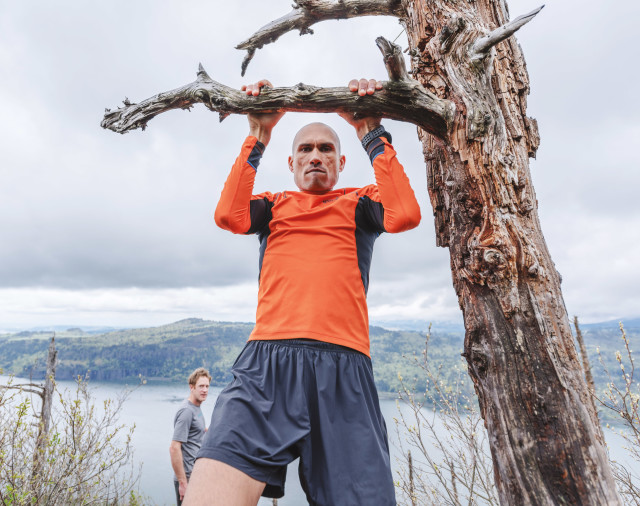
I am ironman: Yassine Diboun (foreground) and Willie McBride on the Gorge’s Angel’s Rest trail, a favored Animal Athletics training ground
Image: Isaac Lane Koval
Popularity aside, a big question remains: with its attendant risks of hypothermia and heat exhaustion, extreme muscle fatigue, kidney failure, and dehydration in remote locations, is this sport a good idea at all?
With their lanky frames and tracksuits, Animal Athletics’ partners offer a textbook image of endurance runners. But their company’s program, including its monthly trail running meet-up at varying locations around Portland, draws women and men from their early twenties to mid-sixties, and a wide range of body types, activity levels,and goals.
“In so many sports you peak when you’re young and fit, and once you’re past your prime, you’re done,” McBride says. “But in ultrarunning, it’s not about being fast or strong in bursts. Mental capacity and pain tolerance prevail, which older men and women have earned through life experience.”
Diboun and McBride met on the trails of Forest Park in 2011. After bonding rapidly over their shared love of punishing workouts, they established Animal Athletics the following year. Their mission statement proclaims an intention “to reconnect people ... to the pleasures of fitness and healthy living and the joys of the natural world ... ” In practice, that translates to working with about 15 trainees at a time, leading them through stair climbs, burpees and squats, hill sprints, and tailored running routes through Portland. Unlike traditional marathons, which emphasize speed and typically take place on smooth city streets, ultras require strict pacing, trail running technique, and a host of additional skills. (The Animal regime also includes instruction in mountaineering skills, like backcountry navigation, which come in handy if someone takes a wrong turn on a 100-mile run in the middle of nowhere.) Tests of endurance, like a regular warm-up of holding arms out for up to 10 minutes, prepare bodies and minds for the mega-long races and all-running “hikes” through the Columbia Gorge the founders themselves prefer.
Zanne Lucy Blu joined up after moving to Portland from Beverly Hills in 2014. “I’m addicted to growing in life, in general,” the 35-year-old hairstylist and spin instructor says. “I love having the ability to explore mountains and beautiful places on foot. You can cover more ground in less time if you just run the whole time.”
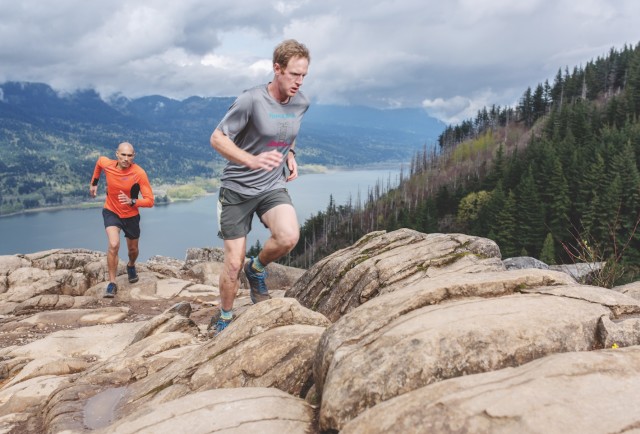
Rock of ages: In contrast to gym-based mainstream fitness culture, ultrarunning emphasizes adventure in remote and rugged terrain.
Image: Isaac Lane Koval
While many Animal Athletics trainees simply want to combat sedentary working lives, others say they want to push themselves well past mere “exercise.” The program’s veterans have summited Antarctica’s Mount Vinson, tackled Ironman triathlons, and celebrated milestone birthdays with 100-mile runs. And like all endurance athletes, they’re prone to issues like IT band pain, stress fractures, and broken hips.
“My doctor hates that I do this to myself,” Diboun admits. McBride avoids doctors, adding, “The majority of people assume it’s not normal, that something’s wrong with us, that it’s not good for you—and in some ways it’s not.”
A 2009 study at Tufts University, observing withdrawal symptoms in compulsively exercising rats, unleashed headlines speculating that running can be as addictive as heroin. (Interestingly, a notable number of Animal Athletics students say they are motivated by maintaining their sobriety.) In 2014, a UC Davis study surveying more than 1,200 ultrarunners showed an increased risk for exercise-induced asthma and injury. But the same study also revealed a shockingly low presence of cancer, heart disease, diabetes, mental health disorders, and even colds and flu. And while 77 percent of the study group had experienced a running-related injury within a year of the research, they recovered quickly: injuries kept the study’s runners away from work or school an average of just 0.3 (yes, zero-point-three) days per year.
“That fine line between pain and euphoria,” Diboun muses, his eyes alight as he recalls a recent race. “I’ve heard some people compare it to childbirth for women. It’s so excruciating and then you forget about it and think, ‘Yeah, I want to have another kid.’”
For Diboun and McBride, the motivation lies in moments of bliss born of rugged connection with fresh air and raw physicality.
“In our culture, everyone’s looking at their phones and focused on career progress,” McBride says. “I think people want challenges far away from that world, far away even from the gym world and machines.” He believes ultrarunning can be a spiritual experience akin to yoga or meditation. “People need to get out and breathe fresh air, just get from here to there in the woods—just go.”
Last September, Diboun found himself alone at the front of a 100-kilometer race across dauntingly steep trails in Patagonia. Just before sunrise, in an area dubbed Fin del Mundo—the End of the World—he saw eyes looking at him from 75 feet away. A long-tailed puma jumped over a log and into his path. “I was by myself, just me and that cat looking at me,” he says, “just as amazed as I was looking at it. And I just kept on going.”
Maybe 50 miles of running had put Diboun in tune with the forces of nature. Or maybe he was just confident that, if pressed, he could outrun the cat.
